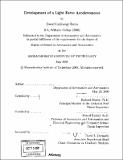Development of a light force accelerometer
Author(s)
Butts, David LaGrange
DownloadFull printable version (44.02Mb)
Other Contributors
Massachusetts Institute of Technology. Dept. of Aeronautics and Astronautics.
Advisor
Richard Stoner and Shaoul Ezekiel.
Terms of use
Metadata
Show full item recordAbstract
In this work, the feasibility of a light force accelerometer was experimentally demonstrated. The light force accelerometer is an optical inertial sensor which uses focused laser light to levitate and trap glass microspheres as proof masses. Acceleration is measured by force rebalancing, which is exerted by radiation pressure from two counter-propagating laser beams. Proof mass displacements are measured by focusing light scattered by the proof mass on a position-sensitive photodetector. A simple model including laser relative intensity noise and shot noise from the measurement of the trapping beam powers estimates that the light force accelerometer could be capable of achieving a sensitivity of < 100 ng/Hz1/2. Essential components of this optical accelerometer, including the levitation of 10 pm glass microspheres in high vacuum and optical force rebalancing, were demonstrated with a single laser beam levitating a microsphere against gravity. Levitated particles are unstable in vacuum because of low viscous forces, so feedback stabilization is necessary for long term trapping. Preliminary performance diagnostics tested the short term sensitivity and bias stability of the apparatus for a constant 1 g acceleration. The factors currently limiting these performance parameters were determined to be bias instabilities associated with measurement of proof mass position and long term biases due to pressure-dependent radiometric effects. Proposed modifications to the current apparatus include the implementation of a two-beam light force accelerometer and a more precise particle position detection method which is less sensitive to proof mass irregularities. This two-beam configuration enables operation in any orientation and permits complete characterization of accelerometer performance. Steps to develop a compact light force sensor in the future are also suggested.
Description
Thesis (S.M.)--Massachusetts Institute of Technology, Dept. of Aeronautics and Astronautics, 2008. Includes bibliographical references (p. 93-96).
Date issued
2008Department
Massachusetts Institute of Technology. Department of Aeronautics and AstronauticsPublisher
Massachusetts Institute of Technology
Keywords
Aeronautics and Astronautics.